Around The 70mm World In Thirty Seven Days |
Read more at in70mm.com The 70mm Newsletter |
| Written and photographed by: Brian Walters, Brisbane, Australia | Date: 04.06.2014 |
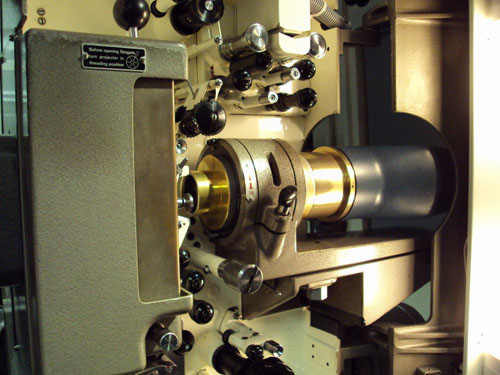 DP70
#1622 in Bradford. Machine donated by Nordisk Film, Denmark in 1998. D-150
lens donated by Dr. Richard Vetter. DP70
#1622 in Bradford. Machine donated by Nordisk Film, Denmark in 1998. D-150
lens donated by Dr. Richard Vetter.The above trip happened this year departing Australia on April 8th and returning home to Brisbane on May 14th. While I did at times feel a bit like Phileas Fogg, having to make key connections for various forms of transport, including planes, trains, buses and ferries, my trip was a little less adventurous but very interesting none the less. First port of call for 70mm viewing was the National Media Museum for the 2014 Wide Screen Weekend International Film Festival. The event was introduced by Duncan McGregor, National Media Museum programmer and one part of his introduction that drew an interesting remark from the row behind me was when he announced that there would be no more screenings of magenta coloured films as part of the Wide Screen Weekend. I could not help but over hear two film enthusiasts sitting behind me say that they would rather watch a faded 70mm roadshow release print than a DCP. These comments obviously reflected their desire to take in the original six track magnetic sound mix of the film with directional dialogue and vocals as well as the sharpness of these quite often first generation prints. My own thoughts were that I found it rather curious that a Media Museum would not wish to show nostalgic, historically significant films because they were faded, especially when these faded 70mm prints may be the only surviving examples of the title in theatrical release format. |
More in 70mm reading: The H8 Down Under The 70mm Trailer Anomaly 70MM Film Event at Biffen, Aalborg Denmark, 26. April 2014 Odyssé til Aalborg Oliver Michael Todd in Conversation with Thomas Hauerslev Widescreen Weekend, Bradford, England DP70 / Universal 70-35 / Norelco AAII - The Todd-AO Projector Internet link: |
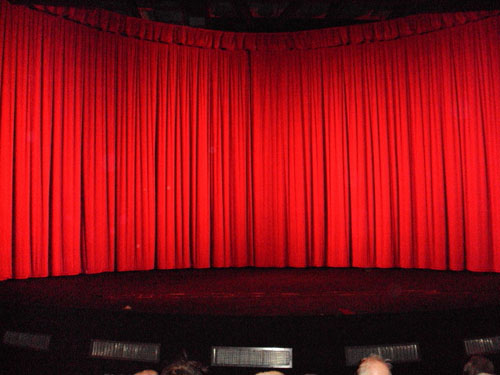 Curved
Stage Curtain in Bradford. Curved
Stage Curtain in Bradford.The event was also to be a 60th anniversary celebration of Vistavision which was showcased by an opening night DCP presentation of “White Christmas“, the first film in the process. This was surprisingly a 2K only version with colours that were a little unnatural and flesh tones that were a little reddish. An original 35mm Dye Transfer Technicolor trailer that screened as part of Sunday’s Cineramacana event showed the original look of the film. Following this screening there was a 70mm screening of " The Big Blue“, what a pleasure it was to view a sharp 70mm blow up with good colour rendition that had a nicely dynamic sound track. On the schedule for Friday was the restored version of the Cinerama travelogue “Seven Wonders Of The World“ presented in DCP 2K format on the curve. The screen result on this was excellent considering the deteriorating condition of the original film elements. David Strohmaier pointed out during his introduction that the preservation scan of the negatives had been done in 3K resolution on each panel, so that technically in the future a 9K DCP could be produced. Due to the fading colour there were limitations to the colour saturation that could be achieved, but overall it looked very good with some movement between panels reminding the audience of the format that they were watching, with the accompanying sound being both directional and dynamic. Following this there was a presentation of the restored 70mm short “Fortress Of Peace“ in 2K DCP format which was restored from a faded positive 70mm print and which looked remarkably good on screen, also presented on the curve. Trailers for "The Golden Head“ and “Search For Paradise“ also looked quite good on the curve screen. In the afternoon there was a 70mm presentation of “Big Trouble In Little China“, an average quality 70mm blow up with a surprisingly subdued sound track with no surrounds evident from this over the top action feature. I decided to skip the DCP evening event of "The Way We Were“ and enjoyed the company of some English projectionist delegates at one of the local pubs, exchanging film projection stories from the good old days. Day three opened with an hilarious introduction by Wolfram Hannemann, of his Widescreen Weekend documentary “Remembering Widescreen“ a series of interviews with organisers and delegates explaining what widescreen meant to them. Following this was an extremely detailed report by Cinerama aficionado David Coles, “Searching For Paradise“ a behind the scenes look at the very challenging conditions that the production team faced during filming. This lead into the restored version of “Search For Paradise” with similar results to the presentation of “Seven Wonders of The World“. Some more severe colour fading to parts of the negative at times, gave the sky a decidedly more green than blue look, where the full original colour was unable to be retrieved from the negatives. After a short break there was the 35mm presentation of “For A Few Dollars More“ which looked wonderful, considering the emulsion area restrictions of the Techniscope process it was filmed in. The Dolby Digital sound track however presented an example of how not to mix a directional dialogue sound track which this mono film never originally had anyway. When four track magnetic dialogue techniques were originally employed the idea was to have the centre channel sound mixed with left channel as the actor moved in that direction to achieve a pseudo L/C sound position and then move into left channel. With the mix on "For A Few Dollars More“ the actor’s voice leapt into left channel only, as soon as the actor made a move in that direction and vice versa for right channel, making for a very annoying sound mix. |
|
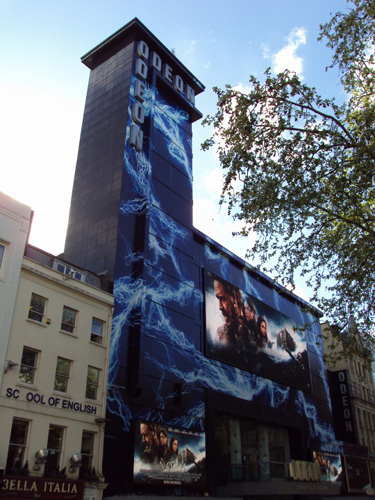 Odeon
Leicester Square, London advertising "Noah". Odeon
Leicester Square, London advertising "Noah".Saturday night was the presentation of “West Side Story“ in 70mm and Datasat sound on the curve, with the original six track sound mix. This was a wonderful presentation with a newish print in good condition, sharp and with little grain. The panning of dialogue and vocals across the five stage channels was exceptional, demonstrating a sound mixing technique that is sadly no longer employed. When watching the famous opening scenes of the film, with the camera looking down on the Manhattan skyline, I couldn’t help but think that this was a blow up from 35mm Panavision, because as soon as we touch down on the basket ball court the image is razor sharp and virtually grainless. When director Robert Wise filmed his next 70mm feature, the Todd-AO production of “The Sound Of Music“ using the even more famous opening aerial shot of Julie Andrews on an Austrian hill top, he used the lighter weight MCS 70 camera as acknowledged in the opening credits for the aerial photography. With this opening, the picture quality is consistent from the aerial shots to the ground shots on the hill top. Could the difference in quality in the opening shots of “West Side Story“ have been because the Super Panavision 70 cameras used for this film were too heavy or large for the helicopter, and Robert Wise was forced to use a lesser format? It was another twelve months or so after the release of “West Side Story“ that the first 70mm feature film blow ups, ie. “Taras Bulba“ and “The Cardinal“ would be released, but Panavision must have had the technology to be able to do this well in development during the production of “West Side Story“, and so could this film have actually contained the first 70mm blow up footage from a 35mm Panavision camera, albeit uncredited in the film ? I have never read anything to this effect, but possibly some readers of in70mm.com may have further information on this, to confirm or refute this theory? Sunday morning was the traditional Cineramacana with a mix of many formats on the flat and curved screen. Highlights were new three strip film presentations of the trailer for “How The West Was Won" and the Renault Daphne ad, thanks must go to Dave Strohmaier for the picture and John H. Mitchell for the sound tracks. Dave Strohmaier pointed out during the introduction that John H. Mitchell’s home based facilities are now the only place on the planet where 35mm full coat magnetic sound tracks can now be recorded since Chase Audio has pulled the plug on this sound format after having completed the sound track recording for “In The Picture“ last year. There are not enough words to adequately acknowledge the incredible contribution that John H. Mitchell has made to the preservation of the original three strip film format of Cinerama. Other films of interest during Cineramacana were two faded reels of 70mm which were well received by the audience, these were from “Camelot“ followed by a tribute to Peter O’Toole with “The Lion In Winter“. Reel six from “My Fair Lady“ in 70mm and full colour from the 1994 restoration was also screened and well received, though the print looked very dark on screen. Later in the day I attended the 70mm presentation of “Terminator 2“ a good blow up, quite sharp and with little grain and a nicely dynamic sound track. The final screening for me was the night session of “It’s A Mad, Mad, Mad, Mad World“ on the curve, projecting an Ultra Panavision 70 squeeze print through an Ultra Panatar 1.25 X 1 anamorphic attachment coupled to an Isco T Kiptagon projection lens. The result on screen had the large negative sharp look of this classic comedy, which I enjoyed far more than I was expecting. Directional dialogue was used but unfortunately only employed on three of the five stage channels in this datasat sound mix. |
|
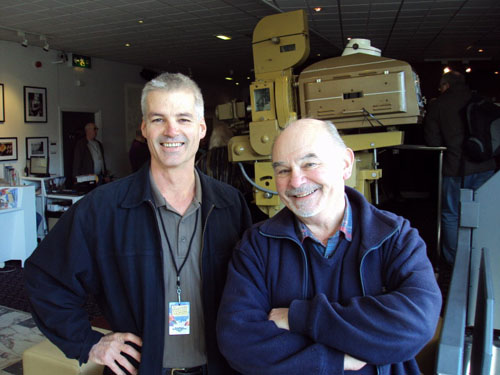 Brian
Walters and Nigel Wolland in front of a GK21 projector. Brian
Walters and Nigel Wolland in front of a GK21 projector.The next day it was off to London and I caught up with Nigel Wolland retired chief projectionist of the Odeon Leicester Square, who was kind enough to give me a guided tour of the nearby cinemas. The Odeon Leicester Square is an incredible venue with it’s huge facade dominating the square. On visiting the bio it was good to see that one of the Cinemeccanica Victoria 8 35 / 70 projectors was still in the bio along with the Chrisitie 35/70 platter, though it has been some time since any 70mm has been screened there. The cinema has separate white and silver screens, with the appropriate screen in place for 2D and 3D presentations. Another interesting cinema was the Prince Charles Theatre which unfortunately no longer has the Philips DP75 projectors but at least has a Kinoton FP30D that is frequently used for 35mm film presentations. Their film enthusiast audience apparently prefers to watch film presentations where possible even to the point of damaged prints, rather than watch a DCP digital presentation. I found this interesting, but understandable as digital imaging in cinemas being more or less the same as what you watch at home on data projectors or large screen television monitors has taken the last point of difference that cinemas had over home entertainment away, and silver screens that have been installed in most complexes for 3D capability further compromise the look of 2D digital presentations. We also visited the bio of the British Film Institute with it’s Imax main auditorium. It was well equipped with two Imax Digital projectors, a double head Imax film projector and associated platters for 2D and 3D presentations. There was also a Century JJ 35 / 70 projector that had a shaft encoder coupled to the projector’s shutter shaft for separate magnetic sound tracks. Their 70mm print of "Ryan’s Daughter" is in this format, with the print being image only and needing a separate full coat magnetic sound track coupled to it for it’s presentation. After a day of London sight - seeing it was enjoyable to have a couple of pints with Nigel in a London pub reflecting on past adventures in cinema projection rooms. One I found particularly interesting was the season of “Notting Hill“ at the Odeon Leicester Square when a super 35 flat print was screened with SDDS only sound to allow for the sprocket hole to sprocket hole image to be projected. This print was specially done to satisfy the film’s director who found the conventional anamorphic print’s picture quality unsatisfactory at the time. This Super 35 flat format was of course utilised to great effect for 70mm blow ups such as “Dance Craze“, “Silverado“ , “Top Gun“ and probably best of all for “Howard’s End“ who’s incredible picture quality in low light and bright scenes alike made it hard to believe that it was in fact a blow up. |
|
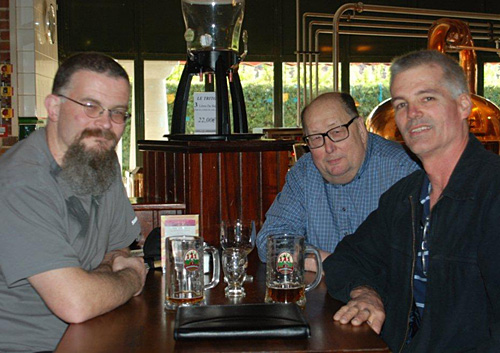 Kris,
the Chief Cinema Technician from the Kinepolis in Lille, Francois Carrin and
myself in a café. Kris,
the Chief Cinema Technician from the Kinepolis in Lille, Francois Carrin and
myself in a café.From London I travelled to France by train where Francois Carrin, Wide Screen Academy Member, met me at the Lille train station to again bless me with local knowledge and give me a guided tour of 70mm cinema points of interest. We visited the 23 screen Kinepolis complex near Lille, which is a most impressive complex. Opened in 1996 near the end of the 70mm era it none the less equipped the seven largest screens with 2 x Century JJ 35/70 projectors on each of these screens. Some of the screens are still 70mm capable, even since it’s change over to digital projection keeping the possibility alive of future 70mm screenings. Francois was kind enough to invite me to stay with him and his wife Nadine for a couple of nights, where I enjoyed some wonderful home cooked French cuisine, before we set off for Paris. In Paris we visited the UGC CINE CITE LES HALLES 27 screen complex the largest cinema complex in France. This also impressive complex is of course all digital and two Philips DP70’s that remain on site are to be set up as a display in the foyer. Francois returned to Valenciennes that afternoon, and the next day I was able to have a look inside the bio of the Max Lindner Panaroma cinema, a large auditorium with a 20 metre curved screen in it. The bio now has one digital and one Kinoton FP30D and the former DP70’s have been removed. The chief projectionist Pascal was on site and I asked him when the last 70mm film was screened there, he said 8 years ago they ran the restored version of “Play Time“, I asked what it looked like on screen, and closing his eyes to remember he said magnifique !! |
|
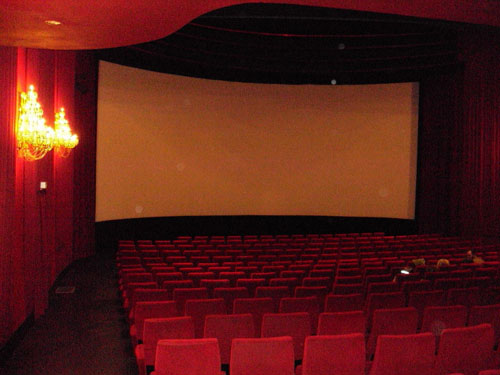 Curved
screen of Schauburg Cinerama, Karlsruhe, Germany. Curved
screen of Schauburg Cinerama, Karlsruhe, Germany.Leaving Paris the next morning I was on a high speed train to Karlsruhe to visit the famous Schauburg Todd AO cinema there, of course also equipped with a Philips DP70. It was Easter Monday and the projectionist on shift gave me a tour of the bio equipped with a Philips DP75 also plus Christie and Kinoton digital projectors with Dolby CP 200 and DTS XD10 sound processors. Unfortunately the annual Todd AO festival at the Schauburg is in October, so I will have to catch up with this on another film odyssey. The next morning I was on my way to Stuttgart to visit 70mm enthusiast Hans Haennsler who had not long returned from the 70mm festival in Krnov in the Czech Republic. Hans showed me what remained of the 70mm sites of Stuttgart and where the famous Atrium cinema was with it’s pair of DP70’s now long gone. A plaque on a wall is all that remains to testify to the glorious wide screen past of this site. |
|
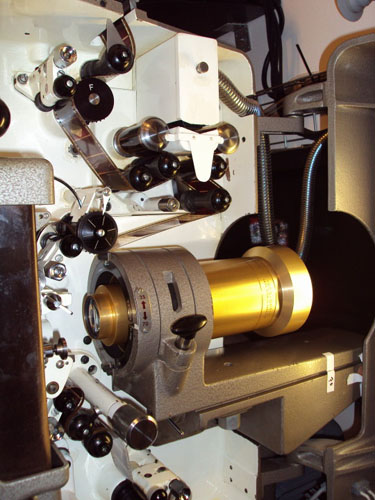 Biffen's
DP70. Biffen's
DP70.Next stop was Copenhagen where it was great to finally meet up with Thomas Hauerslev, the editor, who I have corresponded with for 25 years since Johann Wolthius had first formed the International 70mm association in 1988, bringing like minded wide screen enthusiasts in contact with each other. The next morning Thomas, Anders Olsson, a Swedish 70mm enthusiast, and myself enjoyed a five hour scenic train ride to Aalborg for the very special 70mm event celebrating the twenty fifth anniversary of the ”Biffen“ cinema opening. This turned out to be an amazing day celebrating not only Biffen, but the 70mm film format. The morning session was a screening of "West Side Story" in 70mm and Datasat sound in the original six channel sound mix like in Bradford but using a different print supplied by the Dutch Film Institute. The presentation was superb with the Biffen’s curved screen in perfect proportions for the cinema and the quite steep stadium seating giving you perfect site lines for this in your face, high impact presentation. The image was bright and sharp evenly across the screen with the wonderful original six channel sound mix panning vocals and dialogue beautifully across the stage channels. Following lunch in the foyer Thomas Hauerslev presented an interesting history of the Todd AO process with a PowerPoint presentation that was interspersed with various 70mm film clips. The screening of 65mm test footage used to sell the Todd AO process to Rogers and Hammerstein was fascinating with mock up scenes that would be used in the film and was first screened at a cinema in Buffalo New York in 1953 to convince Rogers and Hammerstein to sell the rights to “Oklahoma!” to the newly formed Magna Theatre Corporation. The film in Ansco colour was still almost full colour and it was interesting to note that the frame lines were in the centre of the sprocket holes not between them so there would have been no framing difference between 35mm and 70mm. This was to change with future release prints, and so a half a hole of framing adjustment was always required between the two formats because of the odd and even amount of sprocket holes per frame difference between the two formats. Other film clips of interest were from the curved screen steep projection angle corrected prints of "Oklahoma!", "The Miracle Of Todd-AO", "Scent of Mystery", "The March Of Todd-AO" and a clip from a recent print of "South Pacific". |
|
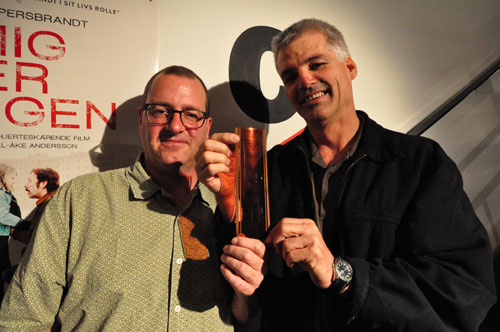 Oliver
Michael Todd and Brian Walters with a 70mm clip from "Around the World in 80
Days". Image by Thomas Hauerslev Oliver
Michael Todd and Brian Walters with a 70mm clip from "Around the World in 80
Days". Image by Thomas HauerslevAt the end of the presentation Thomas interviewed guest of honour Oliver Todd, grandson of Mike Todd for a very interesting insight into his life. After dinner at a nearby restaurant we were treated to a 70mm presentation of “2OO1: A Space Odyssey“ for the evening session. I had not seen this film in 70mm since screening it for six weeks during it’s tenth anniversary re-issue in 1978. This magnetic sound print from the 2001 re-issue was bright, colourful, sharp and with less grain than I was expecting, going on reports on the film at the time of the 2001 re-issue. The sound was certainly the best I had ever heard this film sound and the whole presentation was a wonderful experience in this amazing venue. Orla Nielson can be indeed proud of what he has created in Biffen, and the short film that was screened showing the building and fit out of the cinema complex earlier in the day was so very interesting. The next morning it was another 5 hour train ride back to Copenhagen, but this time with an extra companion as Oliver Todd decided not to fly back to CPH but instead come back with Thomas, Anders and myself on the train. This gave over to further discussion on all things relating to Todd AO and specifically to discussions about “Around The World In 80 Days“ , “Scent of Mystery“ aka “Holiday In Spain“ and Oliver’s young life growing up in rural Ireland where Mike Todd Jnr. moved the family to in the 1960’s. |
|
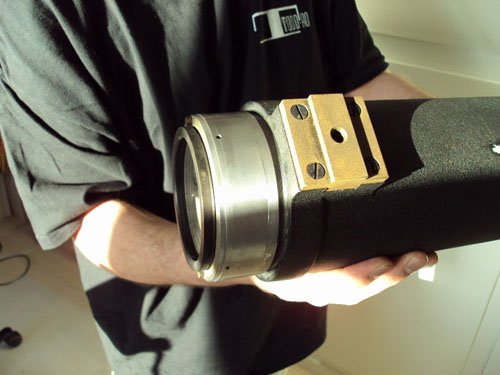 Thomas
Hauerslev with DP70 prototype Todd-AO projection lens. Thomas
Hauerslev with DP70 prototype Todd-AO projection lens.Back in Copenhagen it was great catching up with Thomas and Charlotte at home and also having dinner with Paul Rayton from the famous Egyptian Theatre in Hollywood, who had also attended the event in Aalborg. It is a small world when it comes to 70mm ! Before dinner Thomas was kind enough to show me some of his amazing collection of Todd-AO memorabilia, including the original Todd-AO projection lens that was used to show the 65mm test footage for Rogers and Hammerstein and some of the corrected print, curved frame line test footage of "Oklahoma!". It was wonderful to be able to look at this film history and touch it, rather than looking at a digital hard drive with ones and zeros inside it, this does not have nearly the same appeal! Having a couple of more days in Copenhagen I was able to visit the impressive Imperial Bio projection room where one Philips DP70 is still installed and intact. The cinema boasts Dolby Atmos sound with some 44 surround speakers now mounted down either side wall and along the rear wall as well as two rows of over head surrounds, not to mention two rear sub woofers mounted on the rear wall. |
|
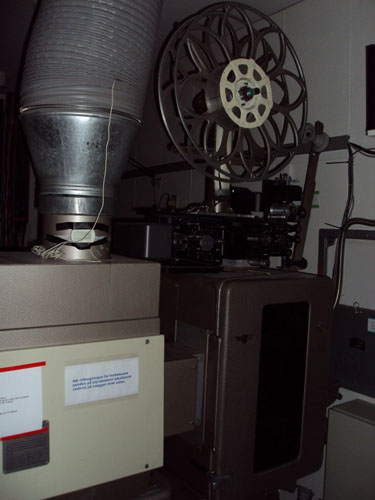 DP70
at Imperial Bio, Copenhagen, Denmark. DP70
at Imperial Bio, Copenhagen, Denmark.A couple of days later after some fascinating site seeing in Denmark with Thomas, I arrived in Malmo Sweden where I met up with 70mm enthusiast Sebastian Rosacker, who was able to get us into the famous Royal Cinema, a large cinema with a 20 metre wide Todd-AO screen now running digital but still equipped with two Philips DP70 projectors that last year screened “Those Magnificent Men In Their Flying Machines“ in 70mm which Sebastian had organised. The large Isco 70mm lenses were still in the lens barrels ready for their next 70mm screening. The next morning I was flying off to Iceland for an overnight stop in Reykjavik before arriving in New York for four nights. While in New York I attended a screen writers awards night at Columbia University with a good friend from Brisbane who is doing a masters in film and television there. Of particular interest was an introduction by Jennifer Lee the award winning writer and director of this year’s huge Disney hit "Frozen". Jennifer, a former Columbia University graduate, gave an inspiring speech to the students where she described cinema as “visual story telling“ this description captures the essence of film making with the sound being the enhancement, but the picture being the fundamental element. |
|
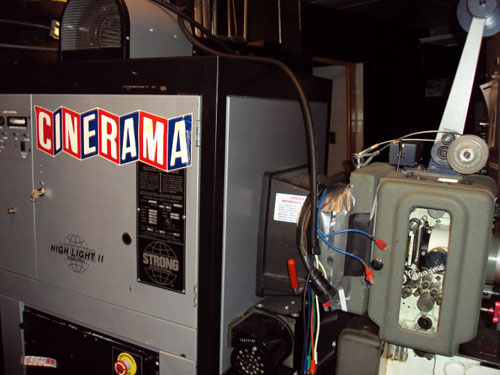 Baker
Cinerama projector, Cinerama Dome, Hollywood, USA. Baker
Cinerama projector, Cinerama Dome, Hollywood, USA.On May 8th I arrived in Hollywood for the final stop over on my world 70mm cinema tour before heading home to Brisbane. The next day I had a guided tour of the Arclight cinema complex and Cinerama Dome main auditorium. In the Arclight bio various pieces of Cinerama cameras and associated equipment lay on the floor in one corner of the projection room. This bio had an early model Philips DP70, serial no. 1121, with two drive motors for the 30 & 24 frame rates. The projector had last shown 70mm film last year with the release there of “The Master“ and was still operational with a Christie 35 / 70 platter placed behind it. The main Cinerama Dome bio has an interesting array of equipment. In the centre bio is the Century Baker Cinerama projector, the Cinerama sound dubber, as well as a 35 / 70 Kinoton FP75 E projector and dual Christie digital projectors stacked vertically. The sound system has a Dolby CP200 as well as a Dolby CP 650, to accommodate all audio formats required. At either ends of this bio are the Able and Charlie Cinerama projectors and some Cinerama film storage racks. The whole Arclight complex is very impressive with large wall to wall screens in all auditoriums and film capabilities in four of the six cinemas which are still regularly used for both 35mm and 70mm presentations. |
|
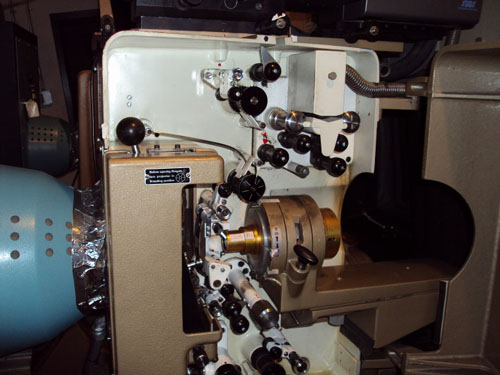 DP70
at Egyptian Theatre, Hollywood Boulevard, Calif., USA. DP70
at Egyptian Theatre, Hollywood Boulevard, Calif., USA.The following day I was then able to visit the bio of the world famous “Chinese Cinema“ which now has no film capability since it’s conversion to an Imax cinema. The bio has two levels where the upper bio has a pair of Christie digital projectors and the bio beneath has a pair of Imax digital projectors. With the upcoming Imax film release of Christopher Nolan’s “Intersteller“, the two Imax digital projectors are to be removed to make room for an Imax film projector and associated platter. The former projection room housing the Philip’s DP70’s no longer exists. The Chinese is the third largest Imax screen in North America and the only Imax cinema in the world to have a full stage curtain which looks quite amazing due to it’s sheer size. The curtain opening to the sound of “Thus Spake Zarathustra“ timed to end as it is completely open is a very dramatic start to the performance. |
|
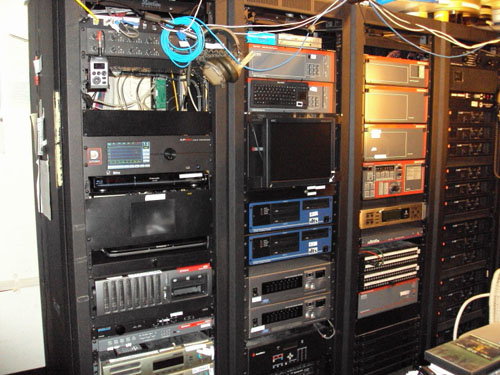 Egyptian
Theatre sound rack. Egyptian
Theatre sound rack.Later that day I caught up with Paul Rayton at “The Egyptian“ Sid Graumann’s other surviving Hollywood picture palace with it’s extremely versatile projection room. Equipped still with a pair of Philip’s DP70’s as well as a Kinoton FP38 for 16 / 35 capability, coupled to a Dolby CP200 and DTS AP20 sound processors with Dolby Digital, Datasat and Sony SDDS digital sound processors. The bio also has an NEC 4K digital projector. It was pleasing to see that 70mm screenings of “Lawrence Of Arabia“ and “Vertigo“ were scheduled later in the month as well as “West Side Story“ in 70mm to screen at it’s sister cinema the “Aero“ in Santa Monica. To finish off the day a short walk up Hollywood Boulevard led me to “The El Capitan“, Disney’s magnificent flagship cinema which also had previously installed DP70’s for 35 / 70mm capability. Today the cinema is Digital projection only with Christie projectors and Dolby Atmos sound capability. The cinema, like the Odeon Leicester Square in London, also has separate white and silver screens with the appropriate screen in place for 2D or 3D presentations. |
|
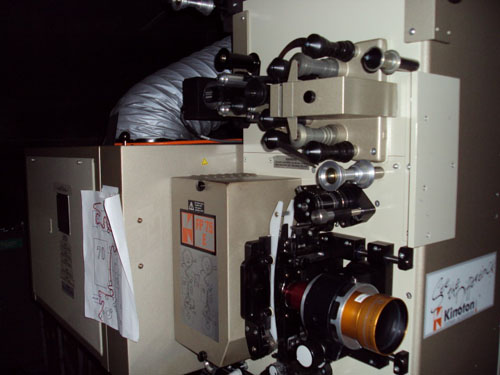 FP75E
70mm projector at the Cinerama Dome, Hollywood, Calif., USA FP75E
70mm projector at the Cinerama Dome, Hollywood, Calif., USALater that night I flew out from Los Angeles, homeward bound after five weeks of touring the cream of the world’s cinemas, experiencing 70mm screenings and visiting a host of projection rooms that are still thankfully 70mm equipped. With world cinema exhibition now dominated by electronic simulations that have replaced photo chemical theatrical release prints, it was refreshing to the eyes to have experienced so many high definition film presentations with their unique colour and contrast giving the image a look that only celluloid can deliver. When reflecting on all the 70mm presentations I watched on my trip it was interesting that all of them had been projected by the Philips DP70 projector, the original, most esteemed and enduring of all Todd AO projectors. I some how doubt that any of today’s digital projectors will still be in active service 60 years from now ! |
|
| Go: back - top - back issues - news index Updated 22-01-25 |
